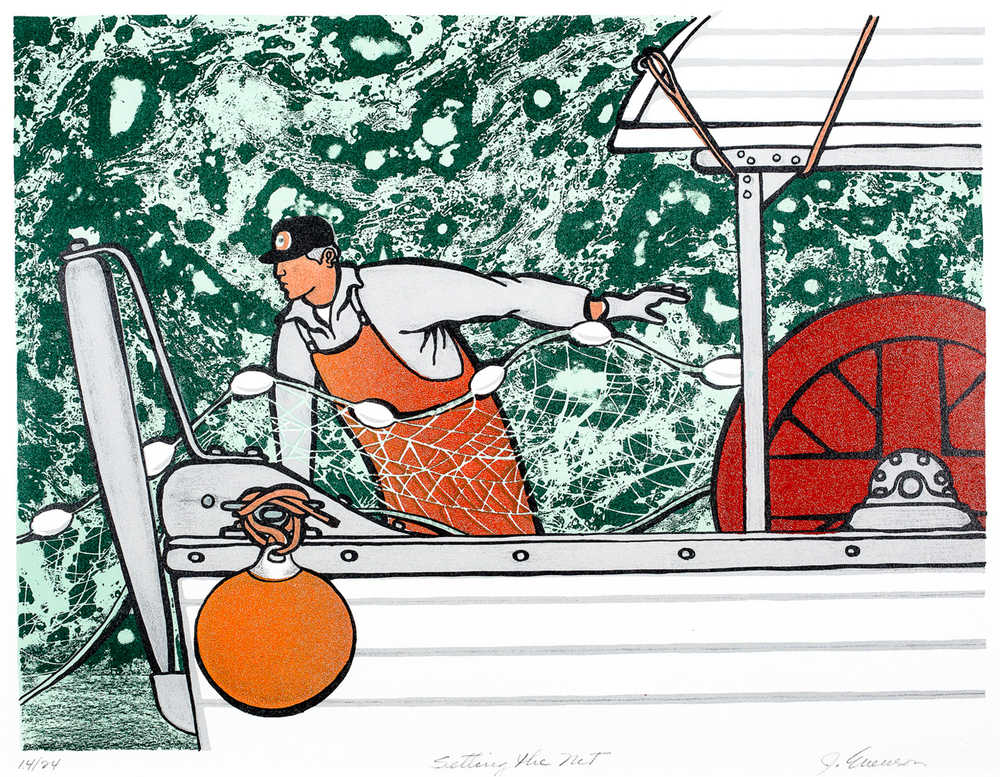A new limited-edition book portrays the long artistic career of Nikiski homesteader, commercial fisherman, and lithographer Jim Evenson with 50 images Evenson chose as favorites.
50 copies of the signed, coffee-table size books have been commissioned by art-supporting nonprofit ARTSpace Soldotna, which plans to establish a scholarship for Kenai Peninsula College art students on behalf of Jim and his wife Nedra Evenson.
The Chicago-born Jim Evenson served in the U.S Navy before art at Grinnell College and the University of Iowa. He came to Kenai with Nedra in the summer of 1955. Evenson originally planned to keep his art teaching job at Cornell University while escaping to Alaska to commercial fish in the summer. Instead, he and Nedra moved to a homestead on the shore of Nikiski’s Bishop Lake. Evenson spent winters teaching art at Kenai Central High School and drift-netted Cook Inlet in the summer.
Commercial fishing provided Evenson with imagery for many of his pieces — or in some, provided him with forms he used to express his sense of line and color. In several prints, the solid shapes of boats sail amid clouds that merge with the sea in whirled compositions that seem to embody both at once. Abstraction and representation co-exist in many of his works, and one occasionally becomes the other — as in “Evening Sky,” where antennae, masts, ladders, and rigging silhouetted against a blue gradient make a formalist mesh of black lines.
Other themes appear within the collection’s 50 prints — among them Evenson’s Christianity and the Kenai Peninsula’s homesteading past — though many don’t contain recognizable objects at all, but only the wild motion of line.
“I’m not after one thing,” Evenson said. “I’m not primarily an artist to make money… I’ve been in a few galleries, but when I do a work of art, it’s something I want to do for myself. Whether I sell it or not is beside the point. If I was really a commercial artist I’d find something that sold and keep repeating it over and over, and I don’t really do that.”
Lithography works through the mutual repulsion of oil and water. A lithographer draws an image on a smooth stone (in Evenson’s case, a slab of German limestone or Italian marble) with a hydrophobic oil or wax. An acid treatment etches the areas of the stone not protected by the drawing material, allowing them to hold water. A layer of oil-based ink rolled over the stone is repulsed by the wet areas and concentrates instead above the original drawn lines, where it is picked up by a piece of paper pressed into the stone. The technique was developed in the 1790s in Germany and is still used to print newspapers in addition to remaining popular with artists.
For the Evensons, lithography is teamwork.
“When we work at the press, he works on one side of the press and I work on the other,” Nedra said. “He does the inking and the determining how much pressure he wants on it and so on. I work on the other side of the press and I do the clean work. I register the prints and remove them, and stack them from the press so we can compare them for similarities.”
Jim and Nedra printed his images in relatively small editions of between 10 to 30 copies.
“That makes them more exclusive, and secondly there’s no reason to print a hundred if you’re only going to want 20,” Nedra said. “The paper’s very expensive.”
Once a print comes off the press, Nedra numbers and files it according to a system she created. She estimated the two of them had printed about 150 editions in their Bishop Lake studio, where many of their prints remain. When ARTSpace director Joe Kashi visited the studio recently, she said he “was four hours in two of the flat drawers — it took him that long to look at the various (prints).”
Kashi said the coffee-table book of Evenson’s work had originally been printed to help the couple register a copyright on Jim’s work. Kashi, an attorney by profession, occasionally leads copyright workshops for artists. Registering a copyright with the U.S Library of Congress requires submitting non-returnable copies of a piece. Kashi said print-on-demmand art books are a good medium for submitting large bodies of work. 20 copies of the Evenson collection where originally printed in 2014 for that purpose, and for distribution to friends and family.
This year the Soldotna Rotary Club paid for the printing of the additional fundraising books, which will sell for $250 each to help fund ARTSpace. The group will sell them at their annual art show and sale, held this Saturday at the Soldotna Public Library.
ARTSpace will also be fundraising for the Evenson scholarship they hope to establish. Kashi said that University of Alaska’s minimum scholarship endowment is $25,000, which he hopes to raise by selling 8-foot-by-4-foot reproductions of Evenson’s lithographs, sold for $2000. These mural-sized prints, Kashi said, will be designed for outside walls and targeted toward businesses or public buildings, “particularly the commercial fishing-themed and the Old Kenai-themed images,” Kashi said.

